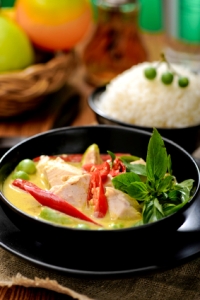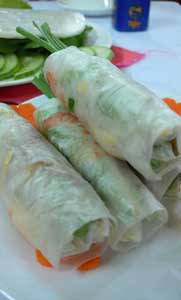 While the Pad Thai from your favorite Thai take-out joint has an average of 500 calories per cup, the food you would eat if you traveled to Thailand is quite different – and better for you.
While the Pad Thai from your favorite Thai take-out joint has an average of 500 calories per cup, the food you would eat if you traveled to Thailand is quite different – and better for you.
According to food blogger and author Joy Buasi from Joy’s Thai Food, Thai cuisine is well known for its fresh ingredients, robust spiciness and complex flavors and aromas. While chili powder, fresh citrus juices and fish stock are common Thai food flavorings, the cuisine is also peppered with peanuts, coconut milk and oil.
If you want to reap the healthy benefits of Thai cuisine, make your own at home so that you can limit the high-calorie ingredients and take advantage of the ingredients full of nutrients.
Add Spice for Your Health
Many Thai dishes are flavored with herbs that have reported health benefits. “Lemongrass, ginger and turmeric help with stomach problems like indigestion, ulcers and inflammation,” said Buasi.
Lemongrass adds an earthy flavor and antimicrobial properties while turmeric, a member of the ginger family, provides natural yellow coloring in Thai food. Garlic, which is the basis of most Thai dishes, is also reported to have a number of health benefits and may boost the immune system.
Be Careful with Curries
One of the most popular dishes in Thailand and in among the Thai food lovers in the United States is green curry- a pale, creamy curry dish usually made with chicken, lemongrass, coriander, lime and eggplant. Because green curry is usually full of coconut milk and vegetable oil, opt for healthier versions of curry like our Beef Curry or a delicious Thai Coconut Chicken Curry from Healthy, Hungry, Happy.
If you have your heart set on a certain recipe but want to save calories, fat and saturated fat, halve the oil and use a substitute for coconut milk. Many grocery stores carry reduced-fat or light coconut milk and in a pinch, you can combine equal parts of low-fat cow’s milk, chicken broth and a teaspoon of brown sugar as a substitute. Some home cooks swear by low-fat almond or soy milk flavored with unsweetened coconut milk.
 Emphasize Fruits, Veggies & Seafood
Emphasize Fruits, Veggies & Seafood
A lot of people automatically think of noodle dishes like Pad Thai when they think of Thai food. Because many noodle dishes are extra-starchy and soaked in oil, you can eliminate a lot of fat and calories from your diet by making low-calorie fruits, vegetables and seafood the cornerstone of your meals. Instead of noodles or fatty meats, use shrimp, mango, papaya, eggplant, corn, pumpkin or lemongrass, all popular Thai ingredients, as the basis of your meals.
“There are a lot of simple Thai recipes that a lot of people don’t know about, but that are very easy to prepare,” said Buasi. Buasi recommends that cooks new to Thai cuisine start with simple soups and salads that use classic preparation techniques and vegetables seasoned with exotic herbs and spices. Yum Ta Krai is a spicy lemongrass salad and Khao Yum is a Thai rice salad believed to help control the cholesterol and is low in calories.
Try some homemade Thai cuisine at home with these recipes:
Glass Noodle Salad with Sweet Shrimp from the Nourish Network
Nam Prik Pao from Chez Pim
Tom Yum Gai from Joy’s Thai Food
Spicy Pork Stir Fry from Blazing Hot Wok

